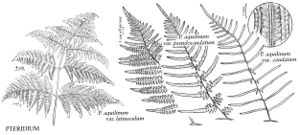Difference between revisions of "Pteridium aquilinum var. caudatum"
Jahrb. Hamburg. Wiss. Anst. Beih. 3: 5. 1897.
FNA>Volume Importer |
FNA>Volume Importer |
||
| Line 23: | Line 23: | ||
}}<!-- | }}<!-- | ||
| − | --><span class="statement" id="st- | + | --><span class="statement" id="st-undefined" data-properties=""><b>Petiole </b>20–75 cm. <b>Blade</b> broadly ovate to deltate, 2–3-pinnate-pinnatifid, 30–100 × 20–80 cm; blades, rachises, and costae usually densely covered abaxially with abundant, straight, stiff, subappressed to spreading hairs. <b>Pinnae</b> all narrowly to broadly triangular; terminal segment of each pinna ca. 10 times longer than wide, longer ultimate segments several times their width apart, ca. 1–2.5 mm wide. <b>Pinnules</b> at nearly 90° angle to costa; fertile ultimate segments only decurrent, or more decurrent than surcurrent. <b>Outer</b> indusia entire, glabrous.</span><!-- |
-->{{Treatment/Body | -->{{Treatment/Body | ||
| Line 52: | Line 52: | ||
|publication year=1897 | |publication year=1897 | ||
|special status= | |special status= | ||
| − | |source xml=https://jpend@bitbucket.org/aafc-mbb/fna- | + | |source xml=https://jpend@bitbucket.org/aafc-mbb/fna-data-curation.git/src/9216fc802291cd3df363fd52122300479582ede7/coarse_grained_fna_xml/V2/V2_511.xml |
|genus=Pteridium | |genus=Pteridium | ||
|species=Pteridium aquilinum | |species=Pteridium aquilinum | ||
|variety=Pteridium aquilinum var. caudatum | |variety=Pteridium aquilinum var. caudatum | ||
| − | |||
| − | |||
| − | |||
| − | |||
| − | |||
| − | |||
| − | |||
| − | |||
| − | |||
| − | |||
| − | |||
| − | |||
| − | |||
| − | |||
| − | |||
| − | |||
| − | |||
}}<!-- | }}<!-- | ||
-->[[Category:Treatment]][[Category:Pteridium aquilinum]] | -->[[Category:Treatment]][[Category:Pteridium aquilinum]] | ||
Revision as of 13:22, 27 July 2019
Petiole 20–75 cm. Blade broadly ovate to deltate, 2–3-pinnate-pinnatifid, 30–100 × 20–80 cm; blades, rachises, and costae usually densely covered abaxially with abundant, straight, stiff, subappressed to spreading hairs. Pinnae all narrowly to broadly triangular; terminal segment of each pinna ca. 10 times longer than wide, longer ultimate segments several times their width apart, ca. 1–2.5 mm wide. Pinnules at nearly 90° angle to costa; fertile ultimate segments only decurrent, or more decurrent than surcurrent. Outer indusia entire, glabrous.
Habitat: In barrens, pine woodlands, and edges of deciduous woods in strongly acid to circumneutral soil, forming large colonies in exposed sites
Elevation: 0 m
Distribution

Fla., Mexico, West Indies, Bermuda, Central America, South America from Colombia to Peru.
Discussion
In Florida and West Indies material, the abaxial surfaces are quite hairy; in Central American material they are often much less hairy.
Selected References
None.
